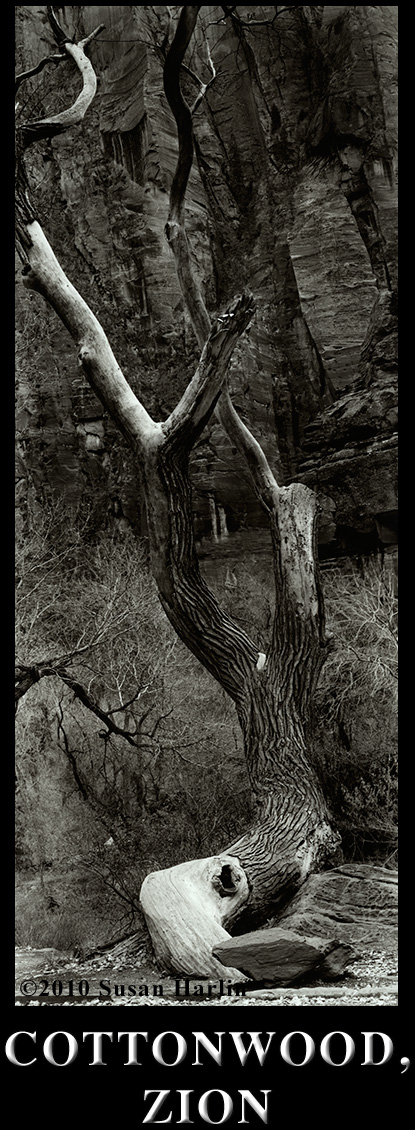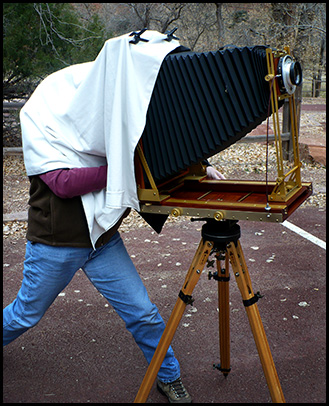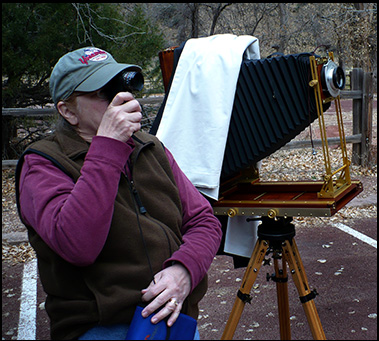
One of our favorite photography haunts is Zion National Park. It is small when compared to many of the other National Parks but the scenery is very diverse. We first visited Zion in 2000. Also known as our Millennium Trip. I am often asked, “Why do you return to the same area year after year? Why not go someplace new?” The location on the map might stay the same but the scenery is ever changing. Trees and rocks after a rainstorm glow and freshly fallen snow will accentuate the delicate sculpture of the rocks. We’ve seen the dry cuts in the rocks give way to a new waterfall booming in flood. Even majestic rocks will occasionally turn loose from their once tight hold on the earth. With each subsequent visit, we have found new areas to photograph and this time would prove to be no different.
This old cottonwood tree has greeted me on numerous trips to Zion. It stands along the Virgin River. Even as the river flows outside her banks during a flash flood, this tree stands defiant. Each year, less bark clings tightly to the tree and during the winter months, a delicate blanket of freshly fallen snow will cover the bare tree where bark use to be providing a white, winter coat. Many trees along the river have succumbed to the elements. But this tree will not give up its space.
On this trip to Utah, we would be spending 11 days in Zion. Even though there was an abundance of sunshine on our first day, the weather would be changing. The forecast for the next seven days would be cloudy.
We had spent most of the day photographing in another part of the valley. Photographing along a secluded stream that ran from the top of the canyon wall down below into the valley. Now it was time to move to another spot to finish out the day.
We ended up at the end of the valley road at the Temple of Sinawava. This spot leads to the Narrows where the Virgin River has cut deep canyon walls for miles. And as predicted, the clouds were beginning to roll in. There are several extremely interesting trees near the parking lot but the old cottonwood stood out. This tree was a familiar sight. . . kind of a landmark. Even though it is dead. . . it still manages to “hang on” for one more year to greet us when we return to Zion. Tourists climb all over the old tree wanting to get their photo made. This tree deserves more than that for it has character.
It was late afternoon and most of the tourists had already left for the day. Not many cars in the parking lot. There was the old cottonwood tree. I knew this would be a good time to make my photograph. After parking the van, I looked around for the best spot to place the tripod. I knew that I didn’t want to place the white, overcast sky in the image. . . an area of white in the corner would detract from the rest of the photograph. Soon I located the right place to setup the tripod and position the camera at the exact place I wanted, which happened to be right in the middle of a parking space. As luck would have it, I was able to set the tripod up next to the van and shoot across the parking lot. A wall of sculpted rock would fill the background in nicely avoiding any bright areas that would have detracted from my tree.
 I knew I wanted to make the photograph with my 8×20 vertical camera. This would provide me with a finished print with the detail that I wanted that could only be obtained with a contact print. There were questions to ask myself. How much of the tree did I want to include? Would this be a photograph of the full tree or only a close detail? I used my viewing filter to aid in my decision on which lens I would use. There are few lenses that will cover the vertical 8×20 format. Most are over 60 years old. The one I chose for this photograph was my 24” Artar. This lens would provide the framing that I wanted with the vertical 8×20 camera.
I knew I wanted to make the photograph with my 8×20 vertical camera. This would provide me with a finished print with the detail that I wanted that could only be obtained with a contact print. There were questions to ask myself. How much of the tree did I want to include? Would this be a photograph of the full tree or only a close detail? I used my viewing filter to aid in my decision on which lens I would use. There are few lenses that will cover the vertical 8×20 format. Most are over 60 years old. The one I chose for this photograph was my 24” Artar. This lens would provide the framing that I wanted with the vertical 8×20 camera.
One of the features that JB added when he was building this camera was the extra tall front standard for additional rise. I raised the lens as far up as it would go. This enabled me to exclude the parking lot in the foreground.
There were broken clouds, diffused light. It was windy and 45 degrees. I metered for my exposure and determined that I would need a N+1 ½ development. I stopped the lens down to f90 and exposed for 24 seconds.
In the finished image the tree appears remote and lost against a wall of rock. That is the effect I was looking for. . . had hoped for. The final contact print was made on Bergger VCCB Warm Tone fiber based paper and Selenium Toned.
Susan Harlin

